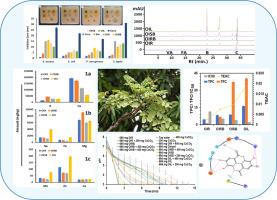籼稻(Oroxylum indicum)不同部位植物化学成分的定量分析Kurz为官方部分(根)与空中部分的循证替代
IF 3.7
Q1 CHEMISTRY, ANALYTICAL
引用次数: 0
摘要
籼稻(Oroxylum indicum)Kurz (OI)或Shyonaka或Sona Patha是一种濒危的药用植物,用于各种传统药物中。成骨不全症的根源是世界范围内许多传统药物制备中最常用的部分。为了保护环境,有必要使用复杂的技术检查用树叶和茎皮等空中部分代替官方部分。本研究采用HPLC和ICP-OES两种方法定量测定了黄芪根、根皮、茎皮和叶四个部分的主要植物成分和金属离子。采用高效液相色谱法测定了植物化学物质香草酸、反式阿魏酸、黄芩素和菊花素的含量,其中黄芩素和菊花素的含量显著高于黄芩素和菊花素;与根和根皮相比,在地上部分(叶和茎皮)中量化了菊花素。ICP-OES元素分析表明,OI的所有部分都是Ca, K, Na, Mg, Mn, Fe和Zn的良好来源。采用气相色谱-质谱法对成骨成骨各部位的挥发性化合物进行鉴定。在抗氧化研究(TPC, TFC和DPPH测定)中,叶显示出较好的IC50值,其次是茎皮,根皮和根。在抗酸研究中,叶表现出较好的抗酸活性,其次是根皮、茎皮和根。在抗菌试验中,OI的所有部分都能显著抑制金黄色葡萄球菌和伤寒沙门氏菌菌株,其中根皮和叶子的活性有所提高。在计算研究中,体外抗酸、抗氧化和抗菌活性得到证实,其中大多数植物化学物质比标准药物表现出结合能。总的来说,这项研究揭示了成骨不全的所有部分,包括根部和地上部分,可能都有药用价值,叶子可能被用作营养食品。此外,官方部分,即传统药物中使用的根或根皮,可以用空气部分(叶或茎皮)代替,以保护环境。经过深入的药理学和毒理学研究,该植物的各个部位都有可能被纳入到药物中。本文章由计算机程序翻译,如有差异,请以英文原文为准。

Quantification of phytochemicals of different parts of Oroxylum indicum (L.) Kurz for the evidence-based substitution of the official part (root) with aerial part
Oroxylum indicum (L.) Kurz (OI) or Shyonaka or Sona Patha is an endangered medicinal plant used in various traditional medicines. The roots of OI are the most commonly used part in preparing numerous traditional medicines worldwide. To conserve the environment, it is necessary to check the substitution of official parts with aerial parts like leaf and stem bark using sophisticated techniques. The present study developed HPLC and ICP-OES methods to quantify OI's main phytoconstituents and metal ions in four parts (root, root bark, stem bark, and leaf). The phytochemicals viz. vanillic acid, trans-ferulic acid, baicalein, and chrysin were quantified by HPLC study, where the significantly better amounts of baicalein and chrysin (baicalein > chrysin) were quantified in aerial parts (leaf and stem bark) as compared to root and root bark. ICP-OES elemental analysis has revealed that all parts of OI are good sources of Ca, K, Na, Mg, Mn, Fe, and Zn. GC–MS study was performed to identify the volatile compounds of all parts of OI. In antioxidant studies (TPC, TFC, and DPPH assays), the leaf showed a better IC50 value, followed by stem bark, root bark, and root. In the antacid study, the leaf has shown better activity, followed by root bark, stem bark, and root. In the anti-bacterial assay, all parts of OI significantly inhibited Staphylococcus aureus and Salmonella typhi strains, where root bark and leaf demonstrated improved activities. In computational studies, the invitro antacid, antioxidant, and anti-bacterial activities were confirmed, where most of the phytochemicals demonstrated binding energies over standard drugs. Overall, the study revealed that all parts of OI, including roots and aerial parts, might be medicinally useful, and leaves may be used as a nutritional food. Moreover, the official part, i.e., root or root bark used in traditional medicines, may be replaced with aerial parts (leaf or stem bark) to conserve the environment. After the in-depth pharmacological and toxicological studies, all parts of OI Oroxylum indicum might be incorporated into pharmaceutics.
求助全文
通过发布文献求助,成功后即可免费获取论文全文。
去求助

 求助内容:
求助内容: 应助结果提醒方式:
应助结果提醒方式:


